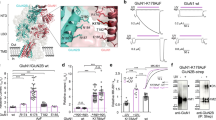Abstract.
Ionotropic ligand-gated channels constitute a large superfamily of channels that provide a molecular basis for synaptic transmission in central and peripheral nervous systems. These channels are subjects of genomic regulation at different levels. The final functional properties of each particular channel are determined by type of gene family, posttranscriptional alterations of messenger RNA (alternative splicing, editing) and subunit composition. In addition, interaction of receptor subunits with postsynaptic density proteins plays a regulatory role and determines targets of channel insertion. In this review, taking glutamate receptor channels as well-studied example, we illustrate how each of these steps may determine receptor function in synapses.
Similar content being viewed by others
Author information
Authors and Affiliations
Rights and permissions
About this article
Cite this article
Burnashev, N., Rozov, A. Genomic control of receptor function. CMLS, Cell. Mol. Life Sci. 57, 1499–1507 (2000). https://doi.org/10.1007/PL00000634
Issue Date:
DOI: https://doi.org/10.1007/PL00000634




